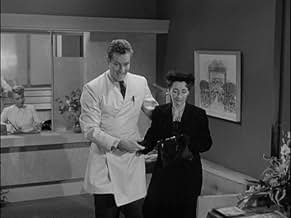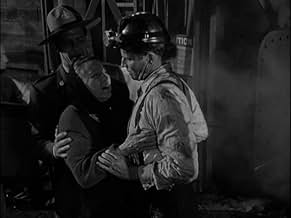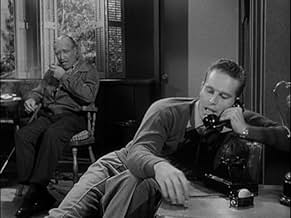NOTE IMDb
5,8/10
1,1 k
MA NOTE
Ajouter une intrigue dans votre langueA doctor returning from the Korean War to his hometown in Pennsylvania must choose what next to do with his life.A doctor returning from the Korean War to his hometown in Pennsylvania must choose what next to do with his life.A doctor returning from the Korean War to his hometown in Pennsylvania must choose what next to do with his life.
- Réalisation
- Scénario
- Casting principal
Philip Ahlm
- Minor Role
- (non crédité)
Elsie Baker
- Mrs. Olzoneski
- (non crédité)
Mary Benoit
- Party Guest
- (non crédité)
Avis à la une
Maybe if John Garfield had been cast instead of Charlton Heston (who looks and moves like Frankinstein's monster here); and if the producers (writers? director?) had not backed away from the mine safety, health, and company criminal negligence theme that packs a punch in the first ten minutes of the movie.
Bad for Each Other ([BFEO) is an obscure modestly regarded film that Charlton Heston made as a Paramount contract employee on loan out to Columbia at the dawn of his cinematic acting career. It was preceded by his excellent western movie Arrowhead, and immediately followed by his well regarded unusual adventure film The Naked Jungle (all made in 1953). BFEO (unlike Arrowhead and The Naked Jungle) is a contemporary social melodrama with a story set in a coal mining suburb of Pittsburgh. Heston is a recently discharged MD who is faced with the usual dilemma such folks often have to deal with: should he be a capitalist and seek out the most lucrative opportunity to practice medicine or a humanitarian and apply his skills to help the less fortunate people in his community? This is the issue at the heart of BFEO.
Heston is conflicted and somewhat self-righteous as he comes to grips with his personal values and convictions. Complicating matters are those individuals who are the major influences in his life: a predatory society woman who has set her sights on him (Lizabeth Scott), an idealistic nurse (Dianne Foster), a young doctor who believes that fulfillment can only come from assisting the poor (Arthur Franz), an older doctor who has a small practice in the mining community (Rhys Williams) and a.mother who believes that he should stay and work in his home town (Mildred Dunnock).
BFEO has a plot that contains echoes from other films: So Big (1932), The Citadel (1938), Not as a Stranger (1955), How Green Was My Valley (1941) and The Best Years of Our Lives (1948). It was directed in workmanlike fashion by veteran Irving Rapper, and the acting is consistently interesting. Heston is sincere, stalwart and occasionally naive in his troubled soul-searching, Scott (cast against type) is a spirited if not entirely credible rich young matron, Foster is a beautiful and appealing supporting player, Franz (a successful TV actor at the time) is quite engaging in his idealistic role, Williams is strong and dependable as always and Dunnock makes a most realistic mother trying to help her son with his choices in life. This excellent cast lifts BFEO from being a routine somewhat derivative entertainment, and the film certainly deserves a fresh reconsideration by a modern audience.
Heston is conflicted and somewhat self-righteous as he comes to grips with his personal values and convictions. Complicating matters are those individuals who are the major influences in his life: a predatory society woman who has set her sights on him (Lizabeth Scott), an idealistic nurse (Dianne Foster), a young doctor who believes that fulfillment can only come from assisting the poor (Arthur Franz), an older doctor who has a small practice in the mining community (Rhys Williams) and a.mother who believes that he should stay and work in his home town (Mildred Dunnock).
BFEO has a plot that contains echoes from other films: So Big (1932), The Citadel (1938), Not as a Stranger (1955), How Green Was My Valley (1941) and The Best Years of Our Lives (1948). It was directed in workmanlike fashion by veteran Irving Rapper, and the acting is consistently interesting. Heston is sincere, stalwart and occasionally naive in his troubled soul-searching, Scott (cast against type) is a spirited if not entirely credible rich young matron, Foster is a beautiful and appealing supporting player, Franz (a successful TV actor at the time) is quite engaging in his idealistic role, Williams is strong and dependable as always and Dunnock makes a most realistic mother trying to help her son with his choices in life. This excellent cast lifts BFEO from being a routine somewhat derivative entertainment, and the film certainly deserves a fresh reconsideration by a modern audience.
Charlton Heston stars as doctor and retired Army colonel Tom Owen. He has returned to his home turf, the small mining town of Coalville. The miners hate him because of something his now-dead brother did years earlier, but the upper crust of Coalville society are excited by the new hunky doctor's arrival. With the help of rich man-eater Helen (Lizabeth Scott), Tom is soon in private practice, catering to the lonely and wealthy women of Coalville. His nurse Joan (Dianne Foster) wants to practice the "right kind of medicine", but is Tom only interested in a fast buck and a good time?
This was just terrible, badly written and even more poorly acted. Heston wins the prize for "Worst in Show", delivering his lines in the most grating, hammy way imaginable, while also exhibiting some of the most overwrought physical business I've ever seen on the screen. The script never fails to tell you how wonderful Heston's Tom Mason is supposed to be, even if we are given scant evidence of it. Every woman falls at his feet, while every man is either in awe or angry with jealousy. Some may enjoy how the movie moves from just bad to amusingly camp, while others will just hit the "stop" button and find something better to do with their remaining time.
This was just terrible, badly written and even more poorly acted. Heston wins the prize for "Worst in Show", delivering his lines in the most grating, hammy way imaginable, while also exhibiting some of the most overwrought physical business I've ever seen on the screen. The script never fails to tell you how wonderful Heston's Tom Mason is supposed to be, even if we are given scant evidence of it. Every woman falls at his feet, while every man is either in awe or angry with jealousy. Some may enjoy how the movie moves from just bad to amusingly camp, while others will just hit the "stop" button and find something better to do with their remaining time.
This film is an 83 minute sermon on selflessness vs selfishness, with particular emphasis on the medical profession. The dialogue is full of grandiose turns of phrase that often mean nothing and do not advance the plot. No one's acting stands out because almost everyone is playing a one-dimensional type.
Charlton Heston stars as the only character with any choices to make or an arc to follow. At the start of the story, he plays a skilled military surgeon on leave after the death of his brother. He is initially content to remain in the army where he has been doing good. However, immediately upon arriving in his old hometown, he is offered two positions in private practice. One serving the poor for little pay, one coddling the wealthy for big bucks. He doesn't even have to think about it. Lizabeth Scott plays his new girlfriend, although there is no chemistry between them at all. They both profess their love for the other, but his interest in her seems to be her rich friends, her interest in him is his status as the current fashion.
In case Heston's "bad choices" are not obvious enough, another young doctor and a nurse who both care more about people than money are provided for contrast. Both came to town because they were so impressed by Heston when he was a "real" doctor while in the army. Could that mean he might yet choose the right path?
Finally, to underline the film's version of right vs wrong choices even further is Mildred Dunnock as Heston's mother. She proudly lives in poverty and is distressed that her two sons both preferred a wealthy lifestyle and the corrupting influence of rich women. Neither of her sons appear to have done anything to help out their mother, not for any reason explained in the script, but just because for the sake of the film, everyone must be identified as poor or rich.
Subtle this script is not. Once everything is set up for us, with all the "correct" choices clearly flagged, the rest of the film is just following a predictable path (with some nonsensical speeches) until Heston reaches all the right conclusions.
Charlton Heston stars as the only character with any choices to make or an arc to follow. At the start of the story, he plays a skilled military surgeon on leave after the death of his brother. He is initially content to remain in the army where he has been doing good. However, immediately upon arriving in his old hometown, he is offered two positions in private practice. One serving the poor for little pay, one coddling the wealthy for big bucks. He doesn't even have to think about it. Lizabeth Scott plays his new girlfriend, although there is no chemistry between them at all. They both profess their love for the other, but his interest in her seems to be her rich friends, her interest in him is his status as the current fashion.
In case Heston's "bad choices" are not obvious enough, another young doctor and a nurse who both care more about people than money are provided for contrast. Both came to town because they were so impressed by Heston when he was a "real" doctor while in the army. Could that mean he might yet choose the right path?
Finally, to underline the film's version of right vs wrong choices even further is Mildred Dunnock as Heston's mother. She proudly lives in poverty and is distressed that her two sons both preferred a wealthy lifestyle and the corrupting influence of rich women. Neither of her sons appear to have done anything to help out their mother, not for any reason explained in the script, but just because for the sake of the film, everyone must be identified as poor or rich.
Subtle this script is not. Once everything is set up for us, with all the "correct" choices clearly flagged, the rest of the film is just following a predictable path (with some nonsensical speeches) until Heston reaches all the right conclusions.
Army surgeon Charlton Heston is happy with his work, but a visit home to the coal-mining town he was born in,as well as society vamp Lizabeth Scott, make him think there's more to life than patching up wounded soldiers. At first he's interested in serving the poor people he grew up with. However Miss Scott gets him a job with society doctor Lester Matthews and becomes engaged to him. He finds his practice consists largely of giving nostrums to wealthy women at $250 a visit. Finally his nurse, Dianne Foster, leaves him to assist Dr. Arthur Franz, who's taking care of the miners and their families. His crisis of faith, however, is yet to come.
Heston has already developed his deep-throated growl in this movie, although he has not perfected it. It has a quality to it that I think is supposed to denote dissatisfaction, but sounds whiny to me. In a world where everyone else struggles for status and wealth, it's up to the woman at the top of both trees to point out the necessity of honesty and honor; well, she's the only one who can.
Heston has already developed his deep-throated growl in this movie, although he has not perfected it. It has a quality to it that I think is supposed to denote dissatisfaction, but sounds whiny to me. In a world where everyone else struggles for status and wealth, it's up to the woman at the top of both trees to point out the necessity of honesty and honor; well, she's the only one who can.
Le saviez-vous
- AnecdotesAccording to December 1950 articles in The Hollywood Reporter and the Los Angeles Times, producer Hal B. Wallis purchased the rights to the novel before it was published for $100,000 ($1.3M in 2024). Wallis intended the leads to be Burt Lancaster and Patricia Neal and that the project was to be filmed at Paramount. It never got off the ground, and Wallis ended up selling the rights to Columbia in early 1953.
- GaffesThe beginning scenes of movie show coal mine operations in Coalville, PA. The railroad caboose was from ATSF (Atchison, Topeka, and Santa Fe). That railroad never had operations in Pennsylvania.
- Citations
Dr. Tom Owen: [on the phone with his wife] Oh, I'm interviewing nurses, of course... Don't be silly, darling - of course she'll be fat and ugly. I do insist on good legs, though.
Meilleurs choix
Connectez-vous pour évaluer et suivre la liste de favoris afin de recevoir des recommandations personnalisées
- How long is Bad for Each Other?Alimenté par Alexa
Détails
- Durée
- 1h 23min(83 min)
- Couleur
Contribuer à cette page
Suggérer une modification ou ajouter du contenu manquant



































